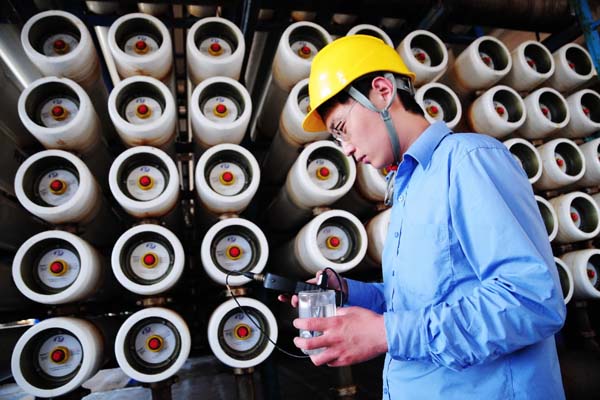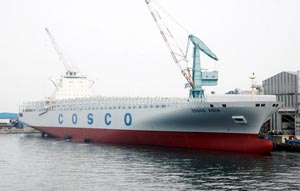

What's the biggest hurdle for a technological revolution in China's water desalination sector?
It's certainly not a lack of potential market. In a country where water shortages have already crippled economic development, processing seawater for drinking and industrial use offers a future not only to the country but also to global investors.
It's no wonder, then, that more than 300 specialists and businessmen from across the world flocked to Tianjin recently, looking for opportunities at the five-day congress of the International Desalination Association.
Jeff Green, founder and CEO of NanoH2O Inc, brought along his latest and most advanced products, hoping to crack open the door of the emerging Chinese market.
|
 |
|
A technician monitors water quality at a desalination plant in Shandong province. China's seawater processing capacity has reached about 760,000 metric tons per day at an average cost of 7 yuan ($1.16) a ton.[Photo/China Daily] |
NanoH2O announced at the congress that a desalination plant with a 45 million yuan ($7.4 million) investment will be set up in Liyang, Jiangsu province, next year, the biggest investment that the company has made abroad.
Green said the plant will supply high-quality reverse osmosis membranes to both domestic and overseas markets. The new products are expected to largely cut down on desalination costs.
He added that the investment was a big decision for the company, but was finally made because they believe the Chinese water desalination market will be worth 6 billion yuan by 2020 and that at least 100 million people in the country will be drinking desalinated water by then.
Reverse osmosis membranes are an essential material used during the desalination process. The water-processing costs are largely decided by the quality of the membranes. Those with higher permeability rates are able to effectively reduce energy consumption when seawater is pumped through the membranes to distill fresh water.
Energy consumption accounts for about half of the total costs of desalination plants in China, said Wang Shichang, a desalination expert at Tianjin University and a co-chair of the International Desalination Association's congress.
Wang said that plants with foreign investors making high-quality membranes will fill in a supply gap and may drive a technological revolution for domestic companies.
 Modified Ford Fiesta by 3D Carbon at SEMA Show
Modified Ford Fiesta by 3D Carbon at SEMA Show
 Modified Ford Fiesta ST by MRT at SEMA Show
Modified Ford Fiesta ST by MRT at SEMA Show
 Modified Ford Fiesta ST by COBB at SEMA Show
Modified Ford Fiesta ST by COBB at SEMA Show
 Hong Kong Optical Fair Kicks off
Hong Kong Optical Fair Kicks off
 The predicted christmas best gifts for children
The predicted christmas best gifts for children
 Voyage to a sustainable future
Voyage to a sustainable future
 Slovak flying car
Slovak flying car
 Model with modified Maserati GranTurismo S
Model with modified Maserati GranTurismo S